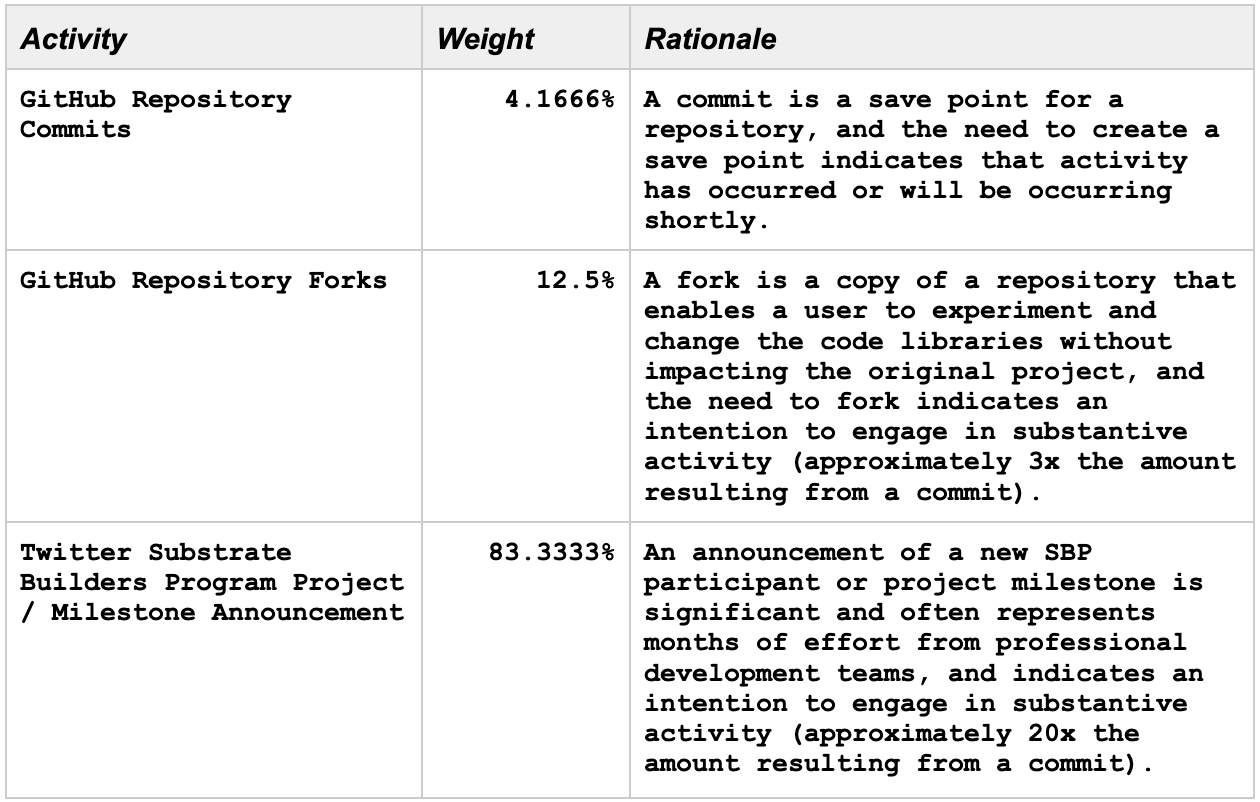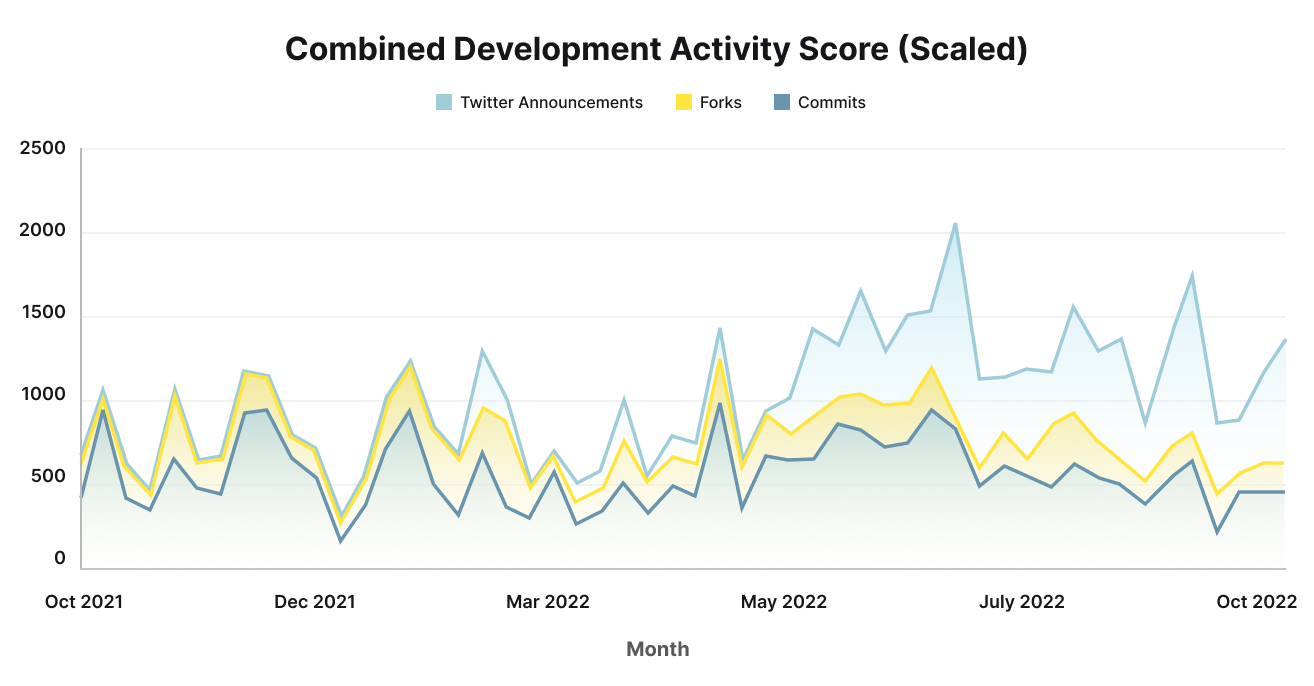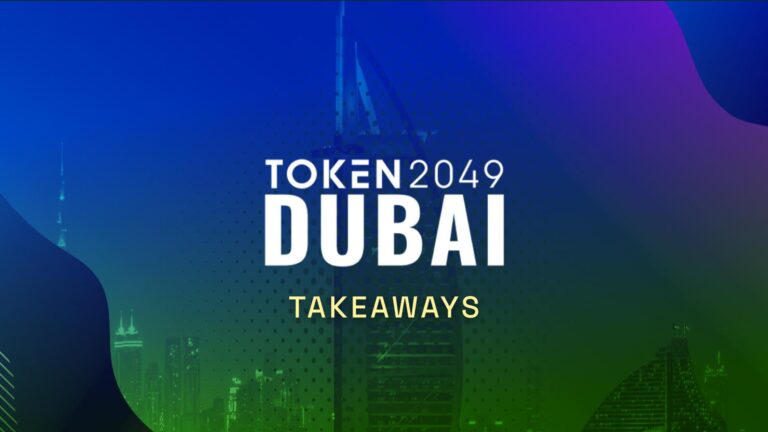What is NEAR Protocol?
NEAR Protocol (NEAR) is a Layer-1 smart contract platform that launched in October 2020 with the aim to drive web3 adoption. NEAR’s focus is on user and developer friendliness, ultra-high scalability and multichain interoperability.
Development activity on NEAR
To track developer activity on NEAR one can take a closer look at repositories on Github and announcements on Twitter. These sources are easily available to the public, while development in private is not easy to track and measure. Nevertheless, research reports from groups like Electric Capital and Outlier Ventures also rely on Github repository activity to measure activity of development communities of blockchain platforms.
For activity on NEAR we analyzed the main NEAR Github repository and its eight most frequently utilized and related repositories (near-explorer, nearcore, create-near-app, docs, near-wallet, near-api-js, sdk-docs, near-sdk-as, near-cli) for commits and forks in the past 12 months. Additionally, three main NEAR-affiliated twitter accounts (@nearprotocol, @pagodaplatform, @nearweek) were scraped for project announcements during the past 12 months. The rationale for scaling each metric to its respective weight is explained below.
A scaled “development activity” score was produced by totaling the following activities each week over the past year and weighing them based on how much each activity is indicative of substantive development activity on Substrate:

An announcement of a new SBP participant or project milestone is significant and often represents months of effort from professional development teams, and indicates an intention to engage in substantive activity (approximately 20x the amount resulting from a commit).
This method of using a scaled score to measure development activity on a week-to-week basis was chosen to aid in comparing the relative popularity of different platforms, as the author plans to analyze other developer platforms in the near future. Over the past year, the development activity by week for NEAR was as follows:

Plotting the above metrics over time shows that there has been not just steady, but growing developer activity on the NEAR network since the market volatility picked up mid-2021. Creating applications and updates for the protocol takes time, and the number of project milestone announcements has indeed trended upwards over the weeks, as evidenced from our above analysis.
As blockchain applications are interoperable, we can hypothesize that an increasing number of completed projects gives future developers more canvas to come in and discover novel use-cases to build additional composable applications on top. This hypothetically leads to an increasing number of users who can take advantage of applications that don’t just exist elsewhere, but offer features that other protocols do not.
Benefits of Building on NEAR
Familiar Languages – NEAR Protocol puts a particularly strong emphasis on developers and their ease of access to the protocol. Rust and AssemblyScript are the main programming languages on NEAR but it also supports TypeScript (typed superset of JavaScript) and any other Web Assembly (Wasm) compliant language. In August 2022 Pagoda (formerly NEAR Inc.) announced the launch of its JavaScript SDK, enabling over 20m+ JavaScript developers to start building in the web3 space.
Developer Tooling – On top of NEAR’s broad programming language approach, it also has a strong tooling set for developers from NEAR-CLI (command line interface) to the NEAR Sandbox for testing and API libraries the protocol offers a strong set of developer tooling.
Unlimited Scalability – NEAR approaches scalability through Nightshade sharding which allows transactions to be run in parallel. NEAR is in the process of rolling out the features of Nightshade and will eventually reach phase 3 with a process called Dynamic Resharding. Dynamic resharding gives NEAR the capability to dynamically split and merge shards (parts) of the blockchain based on the load on the network.
Built-In business model for developers – NEAR awards 30% of fees generated by smart contracts to their contract developers. Other protocols only reward validators and delegators. NEAR goes a step further and directly incentivizes developers to build on NEAR and expand the ecosystem. The developers can then decide to utilize the 30% as revenue, for further community development, expansion of their dApp or a mix of these.
Funds & Grants – NEAR has launched a massive $800m Global Ecosystem Fund to support building out its ecosystem with a particular focus on DeFi projects. Big portions of the fund are designated for new and existing projects through a grants program administered by the NEAR Foundation.
Certification programs & office hour support – NEAR offers an extensive education program with certifications for developers, analysts and generally curious professionals. In cases developers need additional support NEAR has extended office hour slots.
Interoperability through Octopus, Aurora, Rainbow Bridge – There are major infrastructure protocols built on NEAR that give developers interoperability with other major blockchains such as Ethereum and Cosmos. Octopus Network is a multichain interoperability network that allows developers to launch substrate based appchains that are EVM and IBC compatible. Aurora lets developers build Ethereum-compatible apps that have low transaction costs, are safe and scalable.
Growing developer interest since 2021
The recent cryptocurrency market boom of 2021 was perhaps the single largest catalyst that led to the influx of thousands of new developers to Web3. NEAR protocol, given its strengths, was able to increase the total number of developers by almost 4x through 2021, from 100 to approximately 400, according to a report by Electric Capital.
This is no small feat, as NEAR was among the fastest growing blockchains with regards to total developers, among all Web3 ecosystems with between 300-1000 active developers, coming second only to Solana. In the same time period, Bitcoin only gained roughly 10% in new developers, and other established protocols like Cardano and Binance Smart Chain, weren’t even able to double their active developer base.
NEAR protocol recently announced that the network had surpassed the 800 project milestone on their network in July 2022, including DeFi applications, GameFi, DAOs, NFT marketplaces, and cross chain bridges to allow liquidity migration to/from other networks including Ethereum. In addition, the estimate of active developers is more in the range of 1700-2300 as of mid-2022.
Actively inviting developers to migrate to NEAR
The NEAR team has taken several initiatives to both increase and retain the number of developers who have joined the protocol’s ecosystem, as the market has cooled off and liquidity has become more scarce. The protocol has published a plethora of excellent documentation that answers almost any question with loads of tutorials and examples.
NEAR uses the familiar and popular programming languages JavaScript and Rust, so there is no need for developers new to the Web3 space to wrestle learning Solidity or Vyper to deploy their first smart contract. As described on the Near Developer site, “coming from Terra or Solana? With a few tweaks, your Rust contracts will work natively on NEAR.” This push to invite developers to migrate to the network is further evidenced by NEAR publishing a guide to help migrate Terra developers to NEAR after the network’s collapse in May 2022.
Conclusion
Staking supports all the implementations that are being built on the NEAR network. A stable if not increasing number of developers building applications and protocols on top of NEAR over the course of the last year is a leading indicator of network popularity among developers, thereby attesting to the incentive structure that keeps the network growing in perpetuity.
In the above analysis of developer related metrics, Figment affirms its conclusion to have supported this network as an infrastructure provider, since the stability against market conditions from developers indicates that developers are still willing to ‘come to work’ in believing that their applications should be built on top of NEAR’s sharded network and secured by our validator services.
To learn more about staking NEAR, contact sales@figment.io


